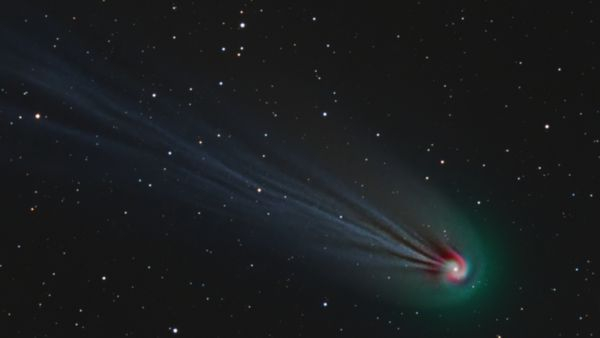Explosive, green 'devil comet' has hidden spiral swirling around its icy heart, photo trickery reveals
New, specially edited photos show a previously unseen swirl of light surrounding the city-size comet 12P/Pons-Brooks, which is currently racing toward the sun and will later zoom past Earth.

The explosive, city-size "devil comet" that is due to fly past Earth later this year has a hidden spiral of light surrounding its gigantic icy heart, new images show. This glowing green swirl would likely have remained undetected without a bit of photo wizardry.
The comet, named 12P/Pons-Brooks (12P), is a 10.5 mile-wide (17 kilometers) ball of ice and rock that circles the sun on a highly elliptical, or stretched, orbit roughly every 71 years and is currently zooming toward our home star.
Like most other comets, 12P has a core of ice, gas and dust surrounded by a frozen shell, or nucleus. The comet's nucleus is in turn enveloped by a cloud of icy dust, known as a coma, that slowly leaks out of the comet's interior. However, unlike most other comets, 12P is cryovolcanic, meaning that it frequently erupts when solar radiation cracks open large fissures in its nucleus, causing it to spray its highly pressurized icy guts, known as cryomagma, into space. When this happens, its coma is significantly expanded, which temporarily makes it appear much brighter than normal.
12P hit the headlines in July last year, when astronomers watched it blow its top for the first time in 69 years. Since then it has continued to erupt fairly frequently. During the initial eruptions, the comet's expanded coma had an irregular shape, caused by a notch in the nucleus that blocked cryomagma outflow. This made the comet look like it had grown demonic horns, which earned the icy object its sinister nickname. However, during more recent eruptions, these horns seem to have disappeared.
As 12P has gotten closer to the sun, its coma — which has a green hue thanks to high levels of dicarbon (two carbon atoms stuck together) — has become much more visible. It has also grown a sizable tail made of dust and ice that is blown away from the coma by solar wind. As a result, astrophotographers are starting to snap much more striking shots of the comet.
On March 9, astrophotographer Jan Erik Vallestad captured highly detailed new images of 12P and its lengthy tail from Norway, and after using specialized software to focus on the varying intensity of the coma's light, he was able to highlight a previously unseen spiral within its coma.
Breaking space news, the latest updates on rocket launches, skywatching events and more!
The spiral can also be seen in pictures by Latvia-based astrophotographer Juris Seņņikovs, who copied the imaging process technique used by Vallestad, Spaceweather.com reported. "Without processing one can easily miss this structure," he told Spaceweather.com.
The spiral shape is likely caused by small geysers on 12P's surface, which are pumping out streams of cryomagma. As the comet spins, these icy jets are being twisted into the swirls that are visible in the new photos, according to Spaceweather.com.
Last month, grainy images of the comet also showed a "yin-yang" shape in the comet's coma, which in retrospect may have been the first evidence of this spiral. But at the time, this connection was not made.
12P is currently barreling through the inner solar system at speeds of around 40,000 mph (64,500 km/h). The comet will reach its closest point to the sun on April 24, after which it will slingshot around our home star and be catapulted past Earth on its way back into the outer reaches of our cosmic neighborhood. It will make its closest approach to Earth on June 2, around which time it should be visible to the naked eye in the night sky.
Astrophotographers have taken several other stunning shots of 12P over the last few months. In January, astrophotographers snapped the comet as it zoomed past the crimson-colored Crescent Nebula. And last week, astronomers with the Virtual Telescope Project hosted a livestream of 12P as it passed by the Andromeda Galaxy in the night sky.
Some astrophotographers are holding out hope that the comet will be visible during the total solar eclipse on April 8, but it will likely take another large cryomagma eruption for 12P to make an appearance during totality.

Harry is a U.K.-based staff writer at Live Science. He studied Marine Biology at the University of Exeter (Penryn campus) and after graduating started his own blog site "Marine Madness," which he continues to run with other ocean enthusiasts. He is also interested in evolution, climate change, robots, space exploration, environmental conservation and anything that's been fossilized. When not at work he can be found watching sci-fi films, playing old Pokemon games or running (probably slower than he'd like).



